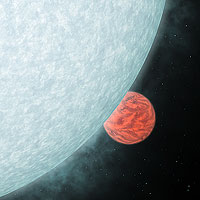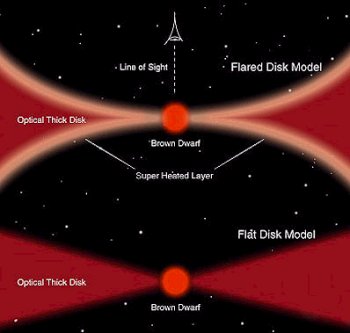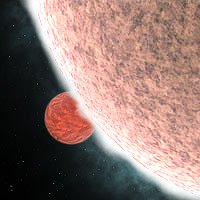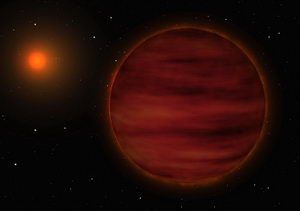Andy Lloyd's Dark Star Theory
3. Is Anyone Even Looking?
One might expect that the astronomical community would be excited at the prospect of discovering this planet/sub-brown dwarf in the Oort Cloud. On the contrary, this subject lies on the very fringe of astronomy, and my own speculations are still more 'out there' than Murray and Matese! The University of Lafayette team, consisting of Matese and Dr Daniel Whitmire et al, attempted to interest NASA in a sky-search for Planet X. They were unsuccessful in even getting the idea seriously considered.

Murray has managed to obtain a scant amount of telescope time at Australia's Royal Observatory (actually, one hour), and has gained a couple of detailed images of the Delphinus constellation over a six month period in order to spot any stars that are on the move in that tiny sky region (1). Remember...Planet X may already have been catalogued as a faint star by astronomers, but its nature not realised. Personally, I think he should look nearer Ophiuchus.
Murray and Matese each have their scientific critics, and there is quite evidently a tremendous amount of work to do to convince the conservative element in astronomy and astrophysics to take their ideas seriously:
"Not everyone shares Murray's easygoing optimism. "I think it's a silly idea. If you tinker with his comet data, the effect just goes away," says astronomer Harold Levison of the Southwest Research Institute in Boulder, Colo., an expert on the Oort cloud. He admits that Earth-sized planets could be floating undetected in the Oort cloud, but he doubts anything as big as Jupiter is hiding out there. "I can't prove it's not true, but incredible claims like this require incredible proofs," he says." (1)
I think their case is strengthened greatly by the mythological evidence available (incredible proof?), which this web-site concentrates on, but my own speculative research does not serve to help their case among the close-minded mainstream science community. Such is the wonderful world of science, folks...
Linda Moulton Howe interviews Dr Matese
The Earthfiles.com web-site has published a rare interview with Professor John Matese, by the respected broadcaster Linda Moulton Howe, regarding the possible existence of a brown dwarf in the Oort Cloud (9). Dr Matese discusses new evidence to back up his initial claims in 1999 about a small brown dwarf potentially existing in the outer Oort Cloud, and discusses the reasons why such a massive object would have escaped direct detection thus far. He also describes his hopes for the next generation of infra-red telescopes, SIRTF and SOFIA. Admitting that he is unable to pinpoint this object to an area less than 5% of the entire sky, he concedes that only luck could bring about an early discovery.

The interviewer, Linda Moulton Howe, also directly addresses the Sitchin issue…a subject that evidently makes Matese inwardly groan. He stands by his earlier dismissals of a tie-in between Nibiru and his brown dwarf, mostly on the grounds of the periods of the orbits, and the visibility of such an object for an ancient civilisation. He notes that he receives a tremendous number of e-mails about Sitchin’s 12th Planet theory, and that his brief perusals of the alternative evidence proposed by supporting researchers (such as myself) have failed to convince him of any possible connection.
On the face of it, of course, he is absolutely right. A brown dwarf ½ light year away and revolving around the Sun every 4 million years could not be one and the same as an object reappearing visibly in the solar system every 3600 years or thereabouts. If that’s all either object ever did. There is a way that his distant brown dwarf might have recently ended up becoming Sitchin’s object. And what’s more, Dr Matese proposed the idea himself! In his own initial paper in Icarus in 1999 Matese wrote the following:
“That is, under the action of the galactic tide the perturber [his brown dwarf] would pass relatively close to the planetary zone every several hundred Myr [million years]… Hills (1985) has determined that the objects of mass <10Mj [Jupiter masses] would not damage planetary orbits even if they had passed through the planetary system.” (2)
Matese gives a perihelion distance for such an ‘oscultation’, or natural fluctuation in the brown dwarf’s orbit, as 125AU (which is about 2-3 times the distance of Pluto from the Sun, well within anyone’s maximum orbital distance for Nibiru). The paper by Jack Hills, that Matese quotes, goes further; providing scenarios where such ‘fly-bys’ by small brown dwarfs might undergo further orbital changes as a result of getting relatively close to the Sun. Such changes tend to result in eccentric elliptical orbits, according to the computer simulations run by Hills. So, if the brown dwarf had acted as Matese himself proposed just a few million years ago, then it could indeed have become a more tightly bound object, one with an orbit of thousands, not millions, of years. That would still be consistent with the comet evidence because these objects were perturbed from their great circular orbits half a light year away over the course of millions of years. Indeed, the fact that Dr Matese cannot pinpoint the position of the Perturber shows how amorphous and flexible his data is.
The implications for our planet's own environment would have been far-reaching.
Indeed, the last Ice Age began suddenly 3.2 million years ago by a mechanism still not understood by scientists.
A Massive, Massive Orbit!
Zecharia Sitchin's hypothesis would place a rogue planet orbiting the Sun within 500 astronomical units at aphelion, but the brown dwarf/massive planet proposed by the astrophysicists Matese and Murray extends such a range to around 30,000AU. In many ways, the former theory is more plausible, simply because it is hard to explain how a planet might be located at tens of thousands of astronomical units distance. There is no known mechanism to help us understand how a planet could form so far away from a star, and many think it unlikely that a 'free-floating' planet might be captured into such an extended orbit. While I suspect that our small data-base of planets dulls us to the potential variety of orbits and inter-stellar dark objects, others remain to be convinced.
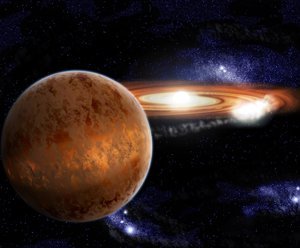
Interesting, then, that researchers have imaged a young, bright planet in a star-forming region whose distance from the nearest star is over 100, 000 astronomical units!
"If the newly spotted object, called SOri70, is in fact a planet, it would be a strange one, sitting 36,000 times farther away from any its nearest stellar neighbor than Jupiter is from our Sun. There is an unresolved debate among experts as to whether an object so far from a star can be called a planet or not. And no one is sure how it might have formed our how it could end up in such a location" (3)
Is this Jupiter-sized planet orbiting the star, or simply free-floating through the region? It's hard to say right now, but imagine this star was the Sun, and the bright planet SOri70 Nibiru/Marduk. The latest finding could set a precedent for a quite extraordinary orbit, in keeping with Matese and Murray's theories. Of course, that doesn't mean that their indirectly detected 'planets' are the same as Sitchin's, but I think it places their proposals on more solid ground.
NASA have declined the opportunity to image this new object with the Hubble Telescope. A pity. We could have captured a glimpse of how our solar system might have looked 4 billion years ago.
Dust Discs around Brown Dwarfs
The Infra-Red Space Observatory run by the European Space Agency completed its work some years ago, before brown dwarfs were being found in reasonable numbers. As such, it had been difficult to obtain data on planet-forming discs that may or may not exist around young brown dwarfs. Thanks to new observations, we can now be fairly certain that planets do indeed form around brown dwarfs, as around young stars.
Thus, any wandering interstellar brown dwarf that chanced its way into the solar system would likely have come with its own contingency of planets/moons, all warmed by the dim light and heat of the dwarf.
The new data concerns Cha HA 2, a young brown dwarf located in the southern constellation Chamaeleon, and the much closer, but older brown dwarf LP 944-20, located in the southern constellation Fornax.
"The first ground-based detection of mid-infrared radiation from two Brown Dwarfs has been achieved by a team of European astronomers, using the Thermal Infrared Multimode Instrument (TIMMI2) on the ESO 3.6-m telescope at the La Silla Observatory (Chile)...The ISO observations hinted at the presence of a dust disk around [one of the] objects - this is fully confirmed by the new TIMMI2 observations. Moreover, the mid-IR radiation measured with this instrument interestingly shows the absence of a strong emission feature from silicates (at about 10 micron wavelength). According to the astronomers, this indicates that the disk around Cha HA 2 is comparatively dense and flat, and without a heated outer layer." (4)
The discs featured in this image are suggestive of a winged appearance for a young brown dwarf system. But older brown dwarfs would presumably lose such discs as orbiting planets/moons are accreted from them. The TIMMI2 data regarding LP 94420, believed to be about 500 - 650 million years old, shows no disc, just infra-red emissions from the dwarf itself. Of course, that's not to say that LP 94420 doesn't have planets orbiting it.
A Binary System's Surprise Planet
Astronomers have been left with no choice but to propose that a planet orbits the main star in the Gamma Cephei binary. They've eliminated every other possible explanation that could account for the star's 2.5 year systematic light variability. No great shakes, you might think, as new planets seem to be popping up everywhere. What's different here is that the binary is a very close one, with the companion star orbiting at about the same distance as Uranus from out Sun. Its gravitational influence should have removed planets from the system long ago.
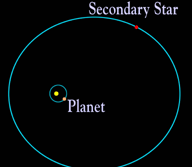
Instead, the planet, bigger than Jupiter, is doggardly orbiting the main star at a distance just greater than that of Mars. This is an unusual finding:
"But planets would be expected to be much rarer in systems like Gamma Cephei that have close companion stars. With nearby stars tugging furiously at one another, they could easily disrupt the orbit of a neighboring planet, according to astronomers."(5)
When a binary system is more loosely bound, astronomers would not be surprised to find planets in either system, of course. If our star has a small companion that is very loosely bound, then the other planets in the solar system would not be affected. But this new finding surely goes further still. If a small star came as close as Uranus, then the planetary orbits nearer to the Sun would not be adversely affected by its tug. This precedent has now been set. It's not predicted, but there we go. Astronomers will have to adjust their assumptions.
If you then take into account that the Sun's proposed companion, Nibiru, is a much less massive entity altogether, of the order of a small brown dwarf, then its perihelion need not have any substantive effect upon the solar system planets.
Planet X is sweeping out the Kuiper Belt - Official!
Astronomers from Britain and Argentina have speculated that Kuiper Belt Object irregularities may point to an Earth-sized planet located at about 60AU. 'Dr Stern told New Scientist the discovery was probably only the first of many. "There are more likely 900 planets in the solar system than nine. And all but eight are in the Kuiper Belt."'
""There's something funny going on out there." Marc Buie of the Lowell Observatory in Arizona is talking about a strange feature at the far edge of our solar system beyond Pluto, among the swarm of small worlds called the Kuiper Belt. It's a wild, uncharted place out there, teeming with icy celestial bodies that may give us essential clues to how the planets formed. It may even be a breeding ground for life. But what's intriguing Buie at the moment is the very edge, about 50 times further out from the Sun than the Earth's orbit. Here, at the "Kuiper Cliff", the number of astronomical objects drops off precipitously. Buie won't be drawn too far but, when pressed, he speaks of the possibility that some "massive object" has swept the zone clean of debris..." [Heather Couper and Nigel Henbest (6)]
Brunini and Melita's 2002 paper (7) explores a range of possibilities for a planetary body embedded in the Kuiper Belt. Yet this body should have been readily detected by now.

They argue that an inclined orbit creates the best fit, but this still seems to be a mismatch with the lack of evidence for a perturber within 80AU. Instead, an inclined orbit for a most distant object with a highly eccentric orbit could explain the data while being consistent with its current absence within the Kuiper Belt. Sounds familiar?
Discussions with Dr Melita indicate that he is working on models whereby the hidden planetary object shows a more elliptical path, and his findings thus far have been encouraging. I will be including material on this research in my new book 'The Dark Star'.
Brown Dwarf at the Right Distance
Only 12 light years away, the star Epsilon Indi has been found to have a surprise brown dwarf companion, which was spotted by examining various photographic plates to the star's immediate vicinity. The star experienced no tell-tale wobble because the brown dwarf is orbiting at a whooping 1500 Astronomical Units.
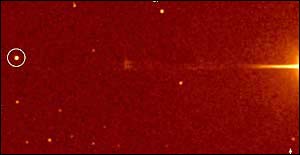
This is a promising development because I think it likely that the Sun's own smaller and darker companion achieves aphelion between 500 and 2000AU. Given the evidence of Epsilon Indi B, this does not appear to be all that unreasonable.
"The failed star and its companion form a wide binary system, separated by more than 1,500 times the distance between the Sun and the Earth.
The object was first identified from archived photographs and later confirmed with observations with the European Southern Observatory 3.5-metre New Technology Telescope at the La Silla Observatory in South America. Astronomers estimate that Epsilon Indi B has a mass just 45 times that of Jupiter, the largest planet in our Solar System, and a surface temperature of only 1,000 Celsius." (8)
